If you are coming from the east, Darwin is the stepping off point for the Kimberley. From a boating perspective, the only real negative for Darwin is obtaining a marina berth in one of the 4 marinas, all of which are accessed via locks due to the tidal range. Sometimes marina berths are hard to find, particularly in the dry season. Book well in advance and try to avoid the 2-3 weeks leading up to the Darwin to Ambon Yacht Race & Rally, and the Sail Indonesia Rally, both of which normally start around late July, early August. All the marinas require paperwork to be completed, usually in advance of arrival. Comprehensive vessel insurance is a “must have” at all the marinas. Email them a copy of your Certificate of Insurance before arrival.
Darwin is a major support centre for the oil & gas and mining industries, as well as a key maintenance and support centre for the commercial fishing and pearling fleet, a well developed coastal shipping and barge fleet and the Navy’s northern patrol boat fleet. Therefore, it has most of the major suppliers and services required to maintain a cruising vessel. Probably not likely to bother most of us, but if your vessel is over 35 metres, you require a pilot, or a pilot exemption to enter Darwin Harbour limits, regardless of whether it is a private, or commercial vessel.
Anchorages.
The most popular anchorage for cruising vessels is in Fannie Bay, off the Darwin Sailing Club 12° 25.54 S – 130° 49.56E. The up side is that the Darwin Sailing Club is a welcoming, boatie friendly place with good quality food and a very pleasant place to spend some relaxing time. The down side is that the tidal range makes it difficult to move a dingy up and down the beach.
The less popular alternative is in Frances Bay, opposite Stokes Hill Wharf 12° 26.29 S – 130° 51.36 E. The latter is open to the south east breeze and is also affected by the wake of passing fishing boats and work boats moving to and from the Duck Pond. It’s popular with long term live-a-board’s because of it relatively easy dingy landing, as compared to Darwin Sailing Club, and it’s close proximity to the Darwin CBD. It’s a convenient spot to drop the pick if you are waiting for the tide to enter the Duck Pond, Tipperary Waters Marina, or Bayview Marina.
Marinas.
All 4 Marinas in Darwin are entered via locks due to the large tide range. You must prearrange your berth in any of the marinas before you arrive at the lock. They will not allow you into the marinas without prior notice. All the marinas have procedures and paperwork to be completed prior to entry. You should contact your choice of marina well in advance.
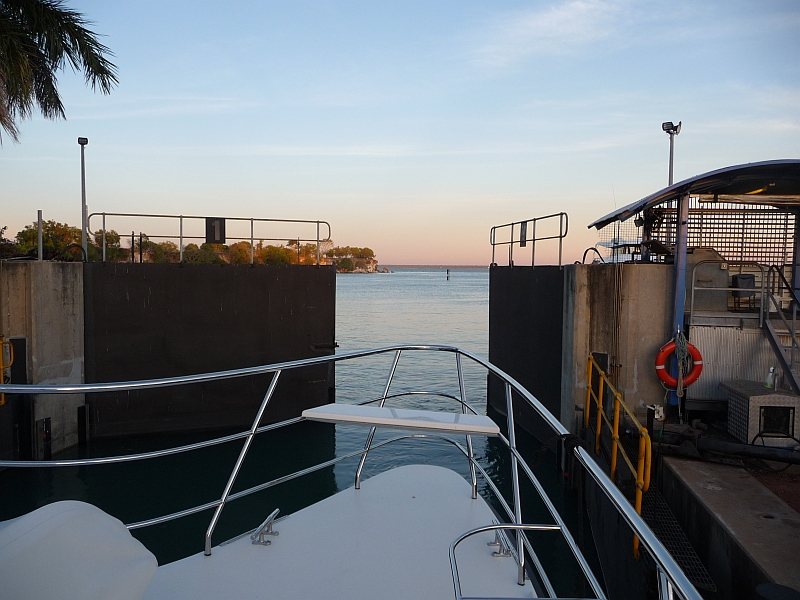 Cullen Bay Marina 12°27.12 S – 130°49.27 E has the only all tide lock, and it also has one of the only two fuel jetties in Darwin harbour used by cruising vessels. The marina is part of a quality residential development, with an array of small shops and good eateries. Darwin Casino and Mindil Markets are about 10-15 minutes walk. The CBD is about 30-35 minutes walk. It has limited rental berths for visiting vessels, and berths over 15 metres are almost unobtainable during the cruising season, so book well in advance. The lock is around 9 metres wide, consequently multihulls over 8.5 metres beam should check with the lockmaster to ensure they will fit through the lock. Cullen Bay does not allow permanent liveaboards, but crew from visiting vessels can stay on board for up to 4 weeks for about an extra $10 per day. There is a haul out facility with limited size capability. Book a time for opening the lock with the lockmaster, 0419 421 363, at least 1 hour in advance, and use VHF Channel 11 when close to the lock, call sign “Cullen Bay Lock”. http://www.cullenbaymarina.com.au/12.html
Cullen Bay Marina 12°27.12 S – 130°49.27 E has the only all tide lock, and it also has one of the only two fuel jetties in Darwin harbour used by cruising vessels. The marina is part of a quality residential development, with an array of small shops and good eateries. Darwin Casino and Mindil Markets are about 10-15 minutes walk. The CBD is about 30-35 minutes walk. It has limited rental berths for visiting vessels, and berths over 15 metres are almost unobtainable during the cruising season, so book well in advance. The lock is around 9 metres wide, consequently multihulls over 8.5 metres beam should check with the lockmaster to ensure they will fit through the lock. Cullen Bay does not allow permanent liveaboards, but crew from visiting vessels can stay on board for up to 4 weeks for about an extra $10 per day. There is a haul out facility with limited size capability. Book a time for opening the lock with the lockmaster, 0419 421 363, at least 1 hour in advance, and use VHF Channel 11 when close to the lock, call sign “Cullen Bay Lock”. http://www.cullenbaymarina.com.au/12.html
Cullen Bay Marina is the unofficial home of the Kimberley Coast Cruising Yacht Club. If you’re mooring there, you’re almost certain to meet up with other KCCYC Members.
Tipperary Waters Marina 12° 26.95 S – 130° 51.08 E Address 86 Frances Bay Drive, Stuart Park NT 0820. A modern marina built within a residential development. Their lock is restricted by tide, requiring some planning as to times of use. Approach past Stokes Hill Wharf, on at least 4.0 metres plus of tide. Call the lockmaster 0407 075 077 well beforehand to arrange a time, and when passing Stokes Hill Wharf use VHF Channel 8, call sign “Tipperary Lock”. The lock will only take up to 6 meters beam. They have 45 berths with maximun length of 22m. A limited number of rental berths are available and accept live-aboards in some of their berths. Best to book well in advance to get a berth. There is a small convenience/liquor store, cafe and fast food shop in the development, and the Darwin CBD is around 20-25 minutes walk. https://tipperarywatersmarina.com.au/ Email lockmaster@tipperarywatersmarina.com.au
There are 2 chandlers near the marina. Nautical Supplies, which is also the RFD liferaft service agent. http://www.nauticalsupplies.com.au/ and Darwin Ship Stores near Fishermans Wharf.
Bayview Marina 12° 26.55 S – 130 51.56 E is the centrepiece of a modern residential development. It is the most likely place to obtain a rental berth in Darwin. The lock is restricted to 7.25 meter beam and 2.5 meter draft. It lies approximately 500 meters further up the same tidal creek as Tipperary Waters Marina, and like Tipperary Waters, it can only be approached on at least 4.0 meters of tide. Call the lock master 0477 661 130 to book an entry time, and use VHF Channel 68, call sign “Bayview Lock” when passing Stokes Hill Wharf. The passage up Sandgroves Creek to the lock is not well marked and has many permanent moorings in the deeper parts of the channel. For first timers, it is recommended to ask advice from the lock master about the tides and the approach channel before you pass Stokes Hill Wharf. There are no shops, or eateries at Bayview, and it is a good 40 minutes walk to the CBD, which can be testing on a humid day. You should plan on hiring a car, or using taxis and buses if staying in Bayview. https://bayviewmarina.com.au/ marinamanager@bayviewmarina.com.au
The Francis Bay Fishing Boat Harbour 12°27.33 S – 130°50.96 E, locally known as “The Duck Pond”, run by the NT Government, is an alternative to the private marinas. http://www.darwinport.nt.gov.au/port-trade-development/frances-bay-marina
It’s primarily a fishing boat harbour for the large pearling, prawn and fishing fleet based in Darwin. If they are busy, they will not take smaller cruising vessels that are able to use the other private marinas. However, in an emergency, or if your vessel is too big to access the other marinas locks, they will usually squeeze a cruising boat in for a short spell. All the services you would expect at a commercial marina are available. It also has 2 great advantages. Firstly, you are able to drive a car, crane, truck etc. on the docks, right up to your vessel for loading gear, or carry out heavy maintenance. Secondly, it is within 15-20 minutes walking distance from the Darwin CBD.
Check the tides before heading in. The approaches past Stokes Hill Wharf almost dry out and at least 3.2 metres of tide is required to get into the lock with a 1.2 metre draft. The lock can get busy at times and there is often a queue, so let them know well in advance that you are coming by phoning the lock master 0401 117 062 and use VHF channel 6 when close, call sign “Duck Pond Lock”.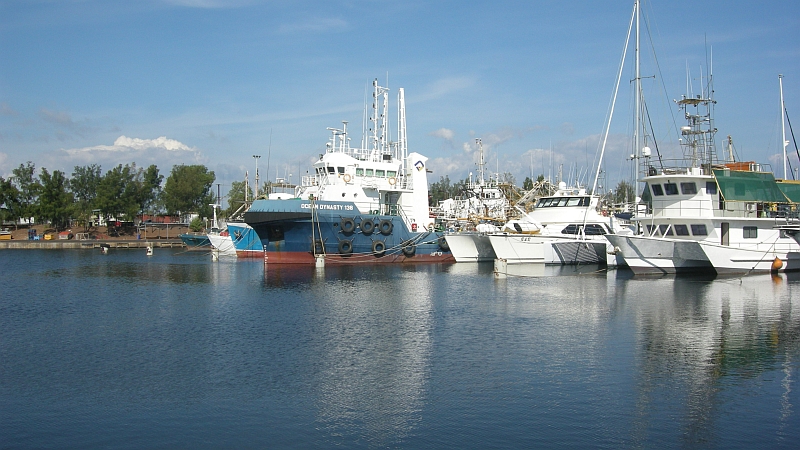
The lock master will allocate you a position on one of the fingers when you are in the lock. There are no pen or berth numbers. You are given direction such as “tie up between the red rig tender and the black prawn trawler on C jetty”. Mooring in the Duck Pond can be interesting and will test your close manoeuvring skills. Berths in the Duck Pond are “Stern To”. You reverse up to fixed concrete jetties, with bows tied to 1 metre diameter steel mooring piles placed about 25 metres off the jetties. Most of these steel piles lost their fenders many years ago, consequently they are very unforgiving if you hit one. The method I use to tie up is to reverse up to the appropriate bow mooring pile, lasso a rope over the pile, then manoeuvre into position to reverse past the pile and back to the jetty, while a crew member walks the bow rope forward ready to tie it off. Reverse towards a jetty bollard, which are about 10 metres apart. When close enough to the jetty, tie a stern rope to the jetty bollard, and then tie off the bow rope to prevent your stern touching the jetty, which is concrete and very unforgiving. From that point you can take your time to adjust your mooring ropes. The jetties are fixed, so don’t tie stern ropes off short, because there is minor tidal movement in the marina caused when the lock is opened. It is common practice to tie off to vessels either side of you, but ask permission first if anyone is on board the vessel.
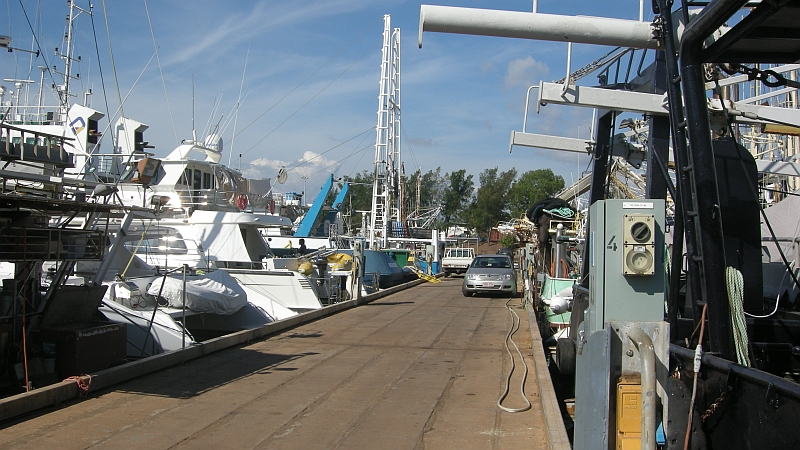
I have witnessed some very interesting and entertaining docking manoeuvres in the Duck Pond, some of which resulted in repairs to paint and stainless steel, as well as a dented ego or two. If your manoeuvring skills are in doubt, launch your tender for a crew member to handle docking lines and to give you a push in the right direction, if needed. Don’t be embarrassed about using your tender to help docking – it is common, and even the professionals will use a tender if they are going into a tight spot. Also, don’t be shy about yelling out to people on the jetty to take a line.
Be warned, it is a commercial marina, where angle grinding, spray painting and general heavy maintenance needed on a commercial fishing fleet is the daily norm. It is also a place where colourful characters, and rugged deckhands abound. If your vessel, or your manner, is proper and pristine, you can expect to get at least one of them a little sullied. We have left R&R at the Duck Pond several times, and have suffered minor damage to the paint from angle grinding swarf, and damage to a rubbing rail caused by a mad barramundi boat skipper, who moved our boat and didn’t tie it up properly. But these minor inconveniences are far outweighed by the fantastic people and personalities who live and work in the commercial vessel industry in Darwin, some of which have become our close friends.
Using the Locks.
There are a few things worth knowing about the locks in Darwin. My power cat R&R is too wide for the Bayview and Tipperary locks, therefore my experience is in the Duck Pond, and Cullen Bay Marina Locks, on 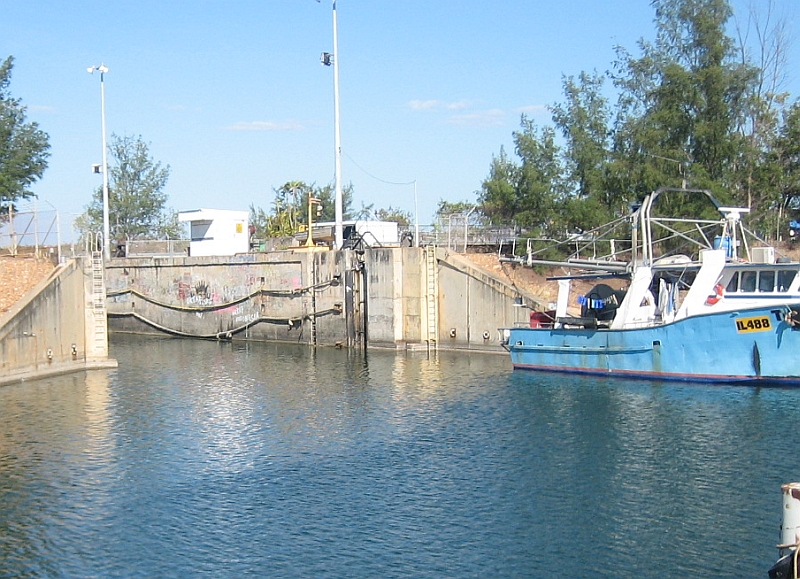 an 21 meter vessel. The other 2 smaller locks may differ.
an 21 meter vessel. The other 2 smaller locks may differ.
The water level in the Cullen Bay lock can rise or fall as much as 5 meters depending on tides. The other 3 locks have slightly less rise and fall of up to around 3-4 meters, because they can only be entered at mid tide range.
- The Lock Master will give you instructions on when to enter and leave the lock, and where to tie up. Stay tuned to the VHF channel used by each lock. Cullen Bay Ch11, Duck Pond Ch6, Tipperary Waters Ch8 and Bayview Ch68.
- Water rushing into the lock can be powerful enough to turn your boat diagonally within the lock.
- Use fenders on both sides. You may find another boat beside you in the lock.
- Depending on the size of your boat, other boats can use the lock at the same time as you. The Lock Master controls this.
- Generally, all the locks require at least 1 hours notice. After hours entry will attract a call out fee.
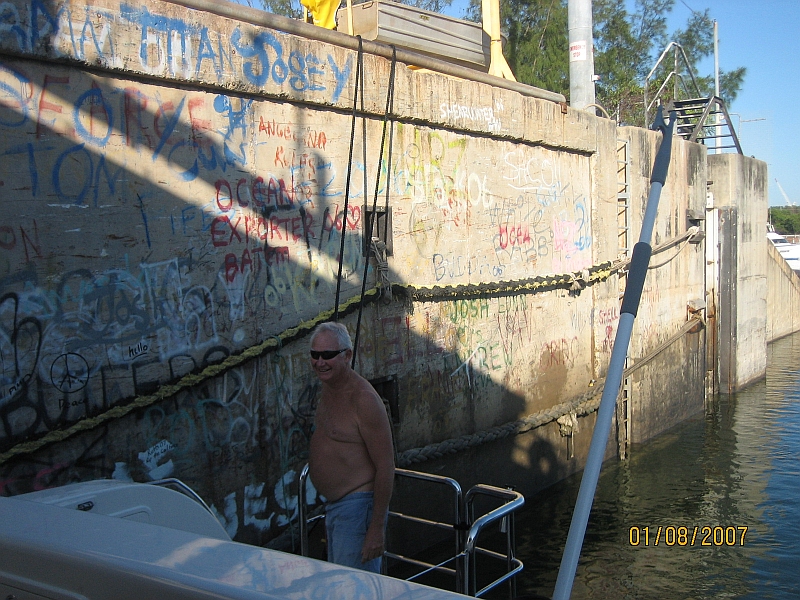
- Have bow and stern lines ready on the side you intend tying up when you enter the lock with a crew member at each. No springers needed.
- The lock masters control all 4 locks from your port side when entering from the seaward side. It is best to tie up that side, allowing the lock master to assist with your lines.
- At the bottom of the tide, you will be well below ground level and will probably have to tie off to steel pipes, or a ladder built into the side of the lock in the case of Cullen Bay, and to heavy ropes lashed to the side of the lock wall in the case of the Duck Pond.
- Don’t “tie off” or “make fast” the lines to your bow and stern cleats. Wrap one bend around the cleat with a crew member holding the bitter end ready to adjust the line in or out.
- Your crew will need to adjust the lines as the water level falls or rises. They need to be on the ball all the time, otherwise you could find your boat hanging off a line as the water level disappears beneath you. Or, in rising water, a line left slack could result in the water rushing into the lock, forcing your bow or stern away from the side of the lock, and twisting your boat diagonally within the lock.
- Keep your engine/s running in case you need to adjust your position. The water rushing in can move your boat. The instructions on some of the locks say to stop your engines when in the lock. I have never done this, because on many occasions I have needed the engines to manoeuvre. My vessel weighs 48 tonnes, and it is not easily moved by my wife hauling on a rope. Smaller vessels may be OK without engine power in the lock
Fuel – The 2 fuel jetties in Darwin used by cruising boats are Cullen Bay Marina 12°27.12 S – 130°49.27 E and Fishermans Wharf 12°27.59 S – 130°51.03 E.
The Cullen Bay Marina fuel jetty can be accessed in all tides, and is located on a floating pontoon arm in the lock basin on the seaward side of the lock. However, for deep draft vessels, be wary about the channel into the basin at spring low tides. It can get shallow and it is flanked by shoals and sand bars. I suggest you wait for more water before entering. The fuel pontoon can only be accessed by one vessel at a time, so at popular times, there may be a queue. The fuel pumps will be obvious when you get there. The same pontoon is also used by ferry operators and fishing charter vessels. If you want to tie up to the pontoon, other than at the fuel pumps, it must be on the southern side of the pontoon, well away from the fuel bowsers The the north side of the pontoon is reserved for ferries only. The fishing charter fleet unload and load passengers on the south side of the pontoon and they have special access rights, so you need to be prepared to move your vessel at short notice if instructed by the lock master, or a skipper on any of the commercial vessels that have privileged docking rights, such as ferries or fishing charter vessels. Your vessel cannot be left there unattended.
The fuel pumps accept major credit cards.
The Fishermans Wharf fuel jetty is accessed past Stokes Hill Wharf. The approaches to the wharf are shallow, and deep draft vessels should allow sufficient tide before entering the wharf basin. Large fishing vessels tie up alongside the wharf in all tides, therefore I suspect the wharf basin itself is dredged to accommodate them.
The fuel sales are operated by Baileys Marine Fuels Australia. Phone 08 8941 3320. You can apply for a Baileys Fuel Card at http://www.baileysmarine.com.au They will also accept major credit cards.
Baileys pumps are very hi flow and you need to adjust the flow at the pump before you use it. Generally, there is a ball valve in each pump enclosure to adjust the flow from stop to fast. My advise is to start very slow and adjust the flow up to what your intake can handle. If you start the flow too fast, you are likely to get blow back from your filler or put high pressure on your fuel tank if the tank breather is not large enough.
The main advantage of using Fishermans Wharf, is that their diesel pumps are all hi-flow. At times, they can also be cheaper than Cullen Bay Marina, but I suggest you compare the prices yourself.
Fishermans wharf is exactly what the name implies. It is often very busy, with commercial boats rafted up 2 or 3 wide against the wharf. At these busy times you can expect to be instructed by the Baileys Fuel staff to tie up beside another vessel. You must then collect the fuel line via the other vessel, passing it over the deck of the other vessel to your boat. Baileys are very strict on safety protocol when fuel is being loaded. You must have one crew member on the jetty at the pump ready to hit the emergency shut off, and another crew member at the hose filler nozzle on your vessel. Ensure you have sufficient, capable crew on board for this purpose.
I have fuelled R&R here several times. One memorable occasion was being rafted up against 5 small harbour tugs tied side by side. The tugs offered absolutely no fore and aft stability and I spent an hour or so sitting at the throttles nudging R&R backwards and forwards to prevent hitting the boats in front and behind us. My crew at the time were not experienced boaters, and they were very unimpressed about having to climb over 5 small tug boats and drag a heavy, dirty fuel line back and forth. However, I have also been the only boat at the wharf at times, and the process has been quick and easy.
Shopping. Being the Northern Territory capital city, Darwin has a well developed business district with all the shops expected of a city this size. There are also large shopping centers in Palmerston and Casuarina. Darwin is a market goers delight, with large and small markets catering for fruit and veg, cloths and art of all types. Mindil Beach Markets are the most well know and popular, and are well worth a visit on a Thursday evening during the dry season just for the food and free entertainment.
Marine Repairs. Many major engine, gearbox, electronics and boating equipment manufacturers are represented in Darwin by local branches or agents. Boat repairs and maintenance are usually not a problem. However, most parts are flown in “overnight” (in Darwin speak this means 2 or 3 nights). During the peak of the cruising season, qualified labour becomes very sought after, so be prepared to wait to get something replaced or repaired.
